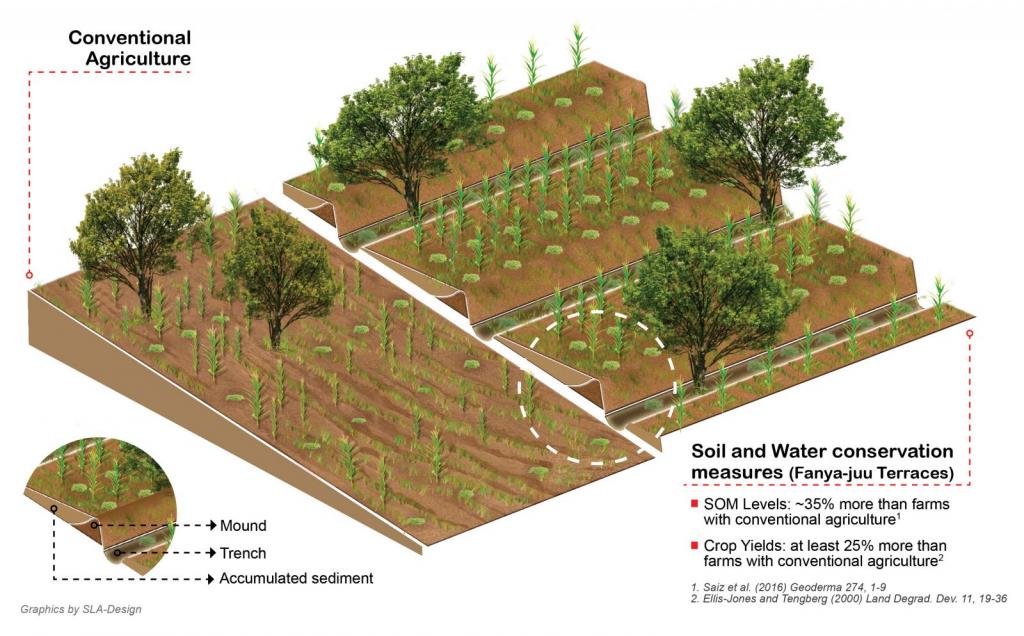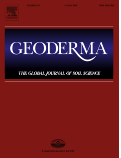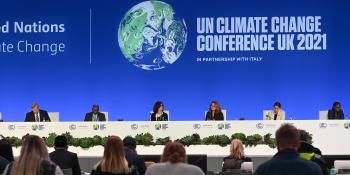Terracing practice increases food security and mitigates climate change in East Africa

Terracing, a common soil and water conservation practice in Kenya, is known to increase agricultural yields; scientists found they also increase soil organic carbon to semi-natural ecosystem levels.
Land degradation has spread to two-thirds of sub-Saharan Africa due, in part to the increased pressure of agriculture to meet the food needs of a growing population and variabilities caused by climate change. But smallholder farmers are fighting to reclaim and revitalize the land, and their efforts in soil and water conservation may be helping more than anyone knew.
An international group of researchers led by the Karlsruhe Institute of Technology (KIT-Germany) found that the long-term impact of Fanya-juu terraces, a soil and water conservation measure employed in degraded agricultural landscapes, is so effective in both preserving valuable topsoil and promoting plant growth that it has led to the recovery of organic matter levels comparable to those observed in neighbouring semi-natural ecosystems. Farms with such terraces store one-third more soil organic matter than farms under conventional agricultural practices.
Fanya-juu terraces have increased crop yields by at least 25% in East Africa, contributing to their increasing use. Fanya-juu means “throw it upwards” in Kiswahili, referring to how these structures are constructed. Farmers dig trenches in fields along contour lines, using the soil to form parallel embankments (mounds) on the up-slope side of each trench Terrace beds develop gradually behind the mounds as soil naturally moves down from the upper part of the terrace, preserving more water and nutrient-rich topsoil than conventional agriculture.

In a comprehensive assessment in Kenya, the team studied multiple farms having terraces established over 30 years ago and compared them with other land uses. Researchers collected and processed nearly one thousand soil samples, analyzing the elemental and stable isotopic composition of carbon and nitrogen along with multiple other variables.
Terraces increase crop yields and carbon sequestration
Gustavo Saiz, research leader, explains:
Terraces have been used by many civilizations throughout history to increase crop yields, restore degraded land and protect human settlements from landslides. Fanya-juu terraces are relatively easy to implement and have the real potential to reduce soil loss, increase crop yields and enhance the sequestration of atmospheric CO2 in the soil.
Organic matter plays a crucial role in determining soil quality, and its enhancement may generate production, adaptation and mitigation benefits through the regulation of carbon, oxygen and plant nutrient cycling. This promotes carbon sequestration and enhanced ecosystem resilience to drought and flooding.
Researchers found that the type of vegetation used by the farmers strongly influences soil dynamics in farms with Fanya-juu terraces, and they provide suggestions for enhancing soil organic matter storage in agricultural sites in light of the experimental results. Dr. Saiz adds:
Fanya-juu terraces help preserve valuable topsoil rich in soil organic matter, thus promoting the use of fewer chemical inputs to sustain yields, which have positive economic and ecological consequences for both farmers’ livelihoods and the environment.
Scaling up
Soil and water conservation measures hold great potential for increasing organic matter levels because the regions where these are implemented are often heavily degraded. Indeed, the semi-arid regions of Africa are reported as having the largest potential for soil organic carbon sequestration in the world. Integrative approaches such as climate–smart agriculture advocate for the implementation of agricultural practices and technologies aiming at increasing productivity in a sustainable manner.
Digging trenches to increase productivity and combat climate change may seem minuscule and old-fashioned, but it is often the simplest and most affordable solution for smallholder farmers with very scarce resources. However, Fanya-juu terraces may not be readily adopted by all farmers as the initial investment required for their establishment could be relatively high and may exceed short term benefits. Therefore, some initial financial aid may be needed for the practice to continue to spread and be available to all farmers.
Establishing terraces will not solely mitigate climate change, but – considering the multiple benefits – it is a small step in the right direction.
Download the article: Saiz G, Wandera FM, Pelster DE, Ngetich W, Okalebo JR, Rufino MC, Butterbach-Bahl K. 2016. Long-term assessment of soil and water conservation measures (Fanya-juu terraces) on soil organic matter in South Eastern Kenya. Geoderma 247:1-9.
In addition to KIT, research was conducted in partnership with CCAFS and scientists from the International Livestock Research Institute (ILRI), the University of Eldoret in Kenya, and the Centre for International Forestry Research (CIFOR). One author is also a member of the CCAFS Climate Food and Farming (CLIFF) Network.
For more information about the research, please email Gustavo Saiz.
For more information about CCAFS work in low emissions agriculture, please contact Julianna White.




